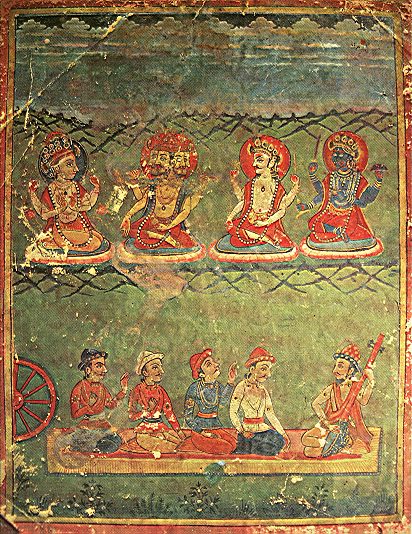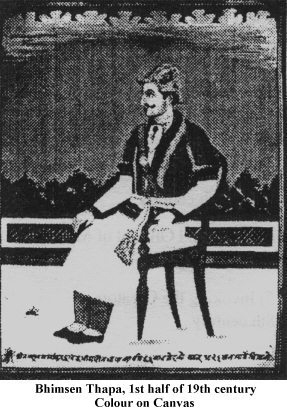
THE CHITRAKAR SOCIETY & HIMALASIA FOUNDATION
jointly presented in September 2000
The Heritage
of Chitrakars - 2000
Nepal's Medieval Heritage of Painting
From Malla Period to Rana Time
at HimalAsia Foundation
in Durga Bhawan, Hadigaon Durbar
Bhat Bhateni, Kathmandu
Text and Concept: Susanne von der Heide
The cabinet exhibition, inaugurated by H.E. Dr. Klaus Barth, Ambassador
of the Federal Republic of Germany and Mr. Bakhat Bahadur Chitrakar,
President of the Chitrakar Society, has shown 30
traditional portrait paintings, iconographical paintings, scrolls and manuscripts
of the 18th and 19th century
The
Significance of the Chitrakars as Painters

Invoking the Creators, Colour on Canvas, 18th century Collection Surendra Lal Chitrakar
Photo © Susanne von der Heide
Through the centuries Nepal has been well known for its rich artistic and
cultural development intimately bound up with the Newar population. The
Newar Chitrakars, and one clan of them in particular, have specialized
in revealing the world in form and colour with all its array of wonders,
that can be admired even today. Generations of these artists have kept
up their work, and thereby helped to form the fundamental richness of the
cultural heritage of Nepal.
Apart from influences from Tibet, the kingdom of Nepal was shaped above
all by the socio-political, religious and cultural sway of India. Nevertheless,
Nepal retained its own identity. The rule of Jayastithi Malla (1382-1395)
brought a change, in the form of a new system oriented towards India's
Hinduism that divided the inhabitants of the valley into profession-based
castes. It was then that the Pun (or Chitrakar) painters aquired the caste
status that would remain within up to the middle of the 20th century.
At the end of the 19th century, and more particularly at the beginning
of the 20th century, the Chitrakar painters, instead of Pun, Pune or Pu,
(soll chinese word for best artist) the Newari name for painter, started
calling themselves by the Nepali equivalent, Citrakár (Anglicized
to Chitrakar).
Traditionally the Chitrakars in general were given exclusive rights to
certain aspects of the Nepalese society. Up to the present they paint for
example at houses and public places, they draw religious pictures and create
ritual masks and ceremonial vessels for festivals and other religious occasions.

Some of the elite among the Chitrakars were also famous for their delicate
frescoes in temples and palaces as well as for their paubha paintings (religious
scrolls) and iconographical illustrations. Furthermore they were masters
in drawing portraits, specially during the Malla and Shah period, later
also including the European styles of the 19th century, and this specially
after the Rana rulers introduced them to European art and even took them
to England and France. The Chitrakars moreover became photographers at
the end of the 19th century, initially taught by members of the Rana society.
Hard though it may have been, they were experts at adapting to the demand
for contemporary artistic work placed by their commissioners.
The practice of shielding the land from outside cultural influences that
had been pursued by the late Malla kings (1382-1768) and the Shahs (1769-1846)
harboured great advantages for the various painting traditions of the Newar
Chitrakars. Because of it the uniquely Nepalese tradition of producing
sketch-books with drawings of religious content, for example, was preserved,
since the Chitrakar painters who were involved in the work remained at
the time only moderately affected by other cultures and their traditions.
Examples of sketch-books are included in the exhibition.
At the beginning of the 19th century, however, interest in Western culture
slowly began to develop among the country's ruling families. Bhimsen Thapa
(1772 or 1779-1839) for example, the prime minister of the country, had
palatial residences built for himself in the classical Newar style, with
 influences
of the Moguls as well as European Neoclassicism even before the Rana families.
In his former residence in Chauni is now located Nepal's National Museum,
and there are found the portraits of him executed by the Chitrakars under
the influence of Mogul painting, but left unsigned in accordance with the
custom of the time.
influences
of the Moguls as well as European Neoclassicism even before the Rana families.
In his former residence in Chauni is now located Nepal's National Museum,
and there are found the portraits of him executed by the Chitrakars under
the influence of Mogul painting, but left unsigned in accordance with the
custom of the time.
The cultural changes in Nepal under the Ranas (1846-1951) were sweeping.
To be sure, tradition, art and culture were not threatened under the Rana
dynasty, but nonetheless the Nepalese aristocracy nourished a growing taste
for Western cultural and consumer goods, which they used to represent their
power (see illustration 'Portrait of Maharaja Bir Shamsher'). In painting,
they were drawn to the naturalism of English artists and an infiltration
of mundane motifs into the religious art of Nepal began.
The first time a Newar artist travelled abroad was when Bhaju Man, a painter
of the Chitrakar caste, formed part of the entourage during Maharaja Jang
Bahadur Rana's journey to England and France in 1850 - a turning point
in the esteem in which Nepalese artists were held, who had hitherto remained
anonymous, given that their fundamentally religiously motivated work was
not judged as an artistic achievement but as merit earned towards a better
rebirth, the goal being the attaining of Nirvana.
A reevaluation of the idea of art occurred in Nepal, namely away from a
type of art motivated by myth and religion towards works that served personal
edification, and hence were purely aesthetic in nature. In the following
years various schools and tendencies arose within this new direction art
had taken, and which the Chitrakar painters had pioneered.
The cabinet exhibition 'The Heritage of Chitrakars - 2000', jointly organised
by the Chitrakar Society and the HimalAsia Foundation, presents some examples
of this traditional historic legacy, showing traditional portrait paintings,
iconographical paintings, scrolls and manuscripts, embracing the late Malla
period and Shah dynasty as well as the early Rana time. The exponates are
partly showing the idealizing, two-dimensional character of Mogul influence
seen in the portraits paintings, even in the early times of the Rana period
that were replaced with the beginning of european impacts more and more
by naturalistic motifs under a logic of spatial perspective, using moreover
new techniques like oil colours and water colours that were the media of
choice.
Susanne von der Heide
|
|
|
Speech of the Chairman of
HimalAsia Foundation
Zongsar Ngari Thingo Rinpoche
Your Excellencies, Distinguished Guests, Ladies and Gentlemen
It is a great pleasure for me to welcome you all to a Cabinet exhibition
of 'Heritage of the Chitrakars - 2000' here in Durga Bhawan, Hadigaon Durbar,
organised by the Chitrakar Society and HimalAsia Foundation.
HimalAsia Foundation, particularly it's Vice Chairlady, Dr. Susanne von
der Heide, is always very happy to have opportunities of promoting art
and culture of Nepal as I myself also do.
Please enjoy this exhibition of a short history of art and clan of artists
for generations of a Nation. It is unique!
Nepal is and has always been extremely rich of art and culture and this
is, that makes this kingdom so special and not only the mountains, eventhough
they are very beautiful. We all must protect and cultivate the culture
and cultural heritage for the sake of the generations to come, and there
are numbers of people who are doing it and I am thankful to them.
I wish you all a very peaceful and happy day to view the exhibition.
thank you very much - Jai Nepal!
List of Paintings
| 1.) Image of Chandramaharoshan
End of 19th century . |
16.) Maharaja Jung Bahadur Rana 2nd half of 19th century . |
|
| 2.) Lord Krishna & Udhava at Dwarika
Early 18th century . |
17.) Colonel Runbirshing Thapa 1832, Bhaju Man Chitrakar . |
|
| 3.) Sesh Narayan
2nd half of 18th century . |
18.) Image of a Dakini End of 19th century . |
|
| 4.) Guhyeswari Temple
End of 19th century . |
19.) Image of a Heruka End of 19th century . |
|
| 5.) Goddess Durga
18th/ beginning 19th century . |
20.) Lord Buddha Shakyamuni 18th century . |
|
| 6.) Bighna Bighnanta
End of 19th century . |
21.) Cosmic Philosophy of Stupa 19th century . |
|
| 7.) Nepali Couple
1st half of 19th century . |
22.) Buddha Amitabha 19th century . |
|
| 8.) Goddess Guhyeswari
End of 19th century . |
23.) Bighna Bighnanta End of 19th century . |
|
| 9.) Maharaja Bir Shamsher
End of 19th century . |
24.) Palace of Queen Damayanti End of 19th century . |
|
| 10.) Prime Minister BhimsenThapa
1st half of 19th century . |
25.) Image of Chandramaharoshan End of 19th century . |
|
| 11.) Chief Kaji Damodar Pande
1st half of 19th century . |
26.) Sketchbook "Expression of Mind in Meditation" 19th century . |
|
| 12.) Red Macchendranath, Patan
End of 19th century . |
27.) Mastersketchbook Manuscript Early 18th century . |
|
| 13.) Image of Mahankal
End of 19th century . |
28.) Scenes of Lord Buddha`s Life and Preachings 18th century . |
|
| 14.) Guard and Official of Malla Court
18th century . |
29.) Goddess Bagalamukhi Early 18th century . |
|
| 15.) Invoking the Creators
18th century |
30.) Image of Lokeshvara Early 18th century |
|
_______________________________________